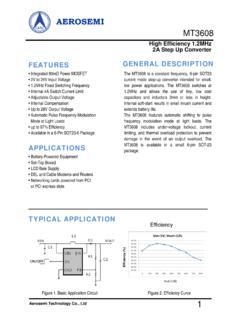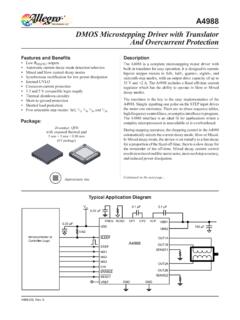Transcription of Pulse Width Modulated (PWM) Drives - Rockwell …
1 Pulse Width Modulated (PWM) DrivesAC Drives Using PWM TechniquesPower Conversion UnitThe block diagram below shows the power conversion unit inPulse Width Modulated (PWM) Drives . In this type of drive, adiode bridge rectifier provides the intermediate DC circuitvoltage. In the intermediate DC circuit, the DC voltage is filteredin a LC low-pass filter. Output frequency and voltage iscontrolled electronically by controlling the Width of the pulses ofvoltage to the , these techniques require switching the inverterpower devices (transistors or IGBTs) on and off many times inorder to generate the proper RMS voltage GeneratorThis switching scheme requires a more complex regulator thanthe Variable Voltage Input (VVI). With the use of amicroprocessor, these complex regulator functions areeffectively handled. Combining a triangle wave and a sine waveproduces the output voltage Conversion Unit (PWM) Pulse Width Modulated (PWM)TriangleGeneratorModulationGenerato rPWMThe triangular signal is the carrier or switching frequency of theinverter.
2 The modulation generator produces a sine wavesignal that determines the Width of the pulses, and thereforethe RMS voltage output of the Width Modulated (PWM)Output of PWM GeneratorPWM Output WaveformsTypes of ControlAC Drives that use PWM techniques have varying levels ofperformance based on control algorithms. There are four basictypes of control for AC Drives today. These are Volts per Hertz,Sensorless Vector Control, Flux Vector Control, and FieldOriented Control. Volts/Hertz control is a basic control method, providing avariable frequency drive for applications like fan and provides fair speed and starting torque, at a reasonablecost. Sensorless Vector control provides better speed regulationand the ability to produce a high starting torque. Flux Vector control provides more precise speed and torquecontrol with dynamic response. Field Oriented Control Drives provide the best speed andtorque regulation available for AC motors.
3 It provides DClike performance for AC motors, and is well suited for typicalDC Width Modulated (PWM)Voltz/HertzVolts/Hertz control in its simplest form takes speed referencecommands from an external source and varies the voltage andfrequency applied to the motor. By maintaining a constantvolts/hertz ratio, the drive can control the speed of theconnected , a current limit block monitors motor current and altersthe frequency command when the motor current exceeds apredetermined value. The volts/hertz block converts the currentcommand to a volts/hertz ratio. It supplies a voltage magnitudecommand to the voltage control block. The angle of this tellsthe voltage where it should be with respect to current. Thisdetermines flux current to the motor. If this angle is incorrect,the motor can operate unstable. Since the angle is notcontrolled in a volts/hertz drive, low speeds and unsteadystates may operate unsatisfactorily.
4 An additional feature innew Drives , a slip compensation block, has improved thespeed control. It alters the frequency reference when the loadchanges to keep the actual motor speed close to the desiredspeed. V/Hz Block DiagramPulse Width Modulated (PWM)While this type of control is very good for many applications, it is notwell suited to applications that require higher dynamic performance,applications where the motor runs at very low speeds, or applications thatrequire direct control of motor torque rather than motor plot above shows the steady state torque performance of avolts/hertz drive. A torque transducer directly on the motor shaft suppliedthe data that is plotted. The drive is given a fixed speed/frequencyreference. Then load on the motor is increased and actual shaft torque that the ability of the drive to maintain high torque output at lowspeeds drops off significantly below 3 hertz.
5 This is a normalcharacteristic of a volts/hertz drive and is one of the reasons that theoperating speed range for volts/hertz Drives is typically around 20:1. Asthe load is increased, the motor speed drops off. This is not an indicationof starting torque. This only shows the ability of the drive to maintaintorque output over a long period of next type of control was developed to address some of Speed vs. TorquePulse Width Modulated (PWM)Sensorless VectorSensorless vector control, like a volts/hertz drive, continues to operate asa frequency control drive with slip compensation keeping actual motorspeed close to the desired speed. The Torque Current Estimator blockdetermines the percent of current that is in phase with the voltage,providing an approximate torque current. This is used to estimate theamount of slip, providing better speed control under control improves upon the basic volts/hertz control technique byproviding both a magnitude and angle between the voltage and Drives only control the voltage magnitude.
6 Voltage anglecontrols the amount of motor current that goes into motor flux enabled bythe Torque Current Estimator. By controlling this angle, low speedoperation and torque control is improved over the standard Vector Block DiagramPulse Width Modulated (PWM)Flux VectorThe flux vector control retains the volts/hertz core and addsadditional blocks around the core to improve the performanceof the drive. A current resolver attempts to identify the fluxand torque producing currents in the motor and makes thesevalues available to other blocks in the drive. A current regulatorthat more accurately controls the motor replaces the currentlimit block. Notice that the output of the current regulator is stilla frequency early versions of flux vector required a speed feedbacksignal (typically an encoder) and also detailed informationabout the motor to properly identify the flux and torquecurrents.
7 This led to the requirement for matched motor/drive combinations. While there is nothing inherently wrong with thisapproach, it does limit the users motor choices and does notoffer independent control of motor flux and vector control improves the dynamic response of thedrive and in some cases can even control motor torque as wellas motor speed. However, it still relies on the basic volts/hertzcore for controlling the Vector Speed vs. TorquePulse Width Modulated (PWM)Recently, flux vector control has been enhanced to allow thedrive to operate without the use of a speed feedback device,relying instead on estimated values for speed feedback and slipcompensation. Again, the basic volts/hertz core is Flux Vector Block DiagramFlux Vector Block DiagramPulse Width Modulated (PWM)This graph shows the steady state torque capability of a fluxvector drive. The speed control has been improved.
8 Second,the torque output capability is better. Note however that there isstill a decrease in the available torque at low speeds. Thisoccurs primarily because the drive still contains the control in its simplest form acknowledges that themotor current in an AC drive is the vector sum of the flux andtorque producing currents. It is because of this that somepeople would point out that even a volts/hertz drive could beconsidered a vector Oriented ControlWhat distinguishes a product using Field Oriented Control froma traditional vector product is its ability to separate andindependently control (or regulate) the motor flux and to the description of Force Technology on the followingpage. Notice that in the definition of Field Oriented Control wedid not say currents in an AC motor . That s because theconcept applies equally well to DC motors and is the reason wecan demonstrate DC like performance using Field OrientedControl on AC Vector Speed vs.
9 TorquePulse Width Modulated (PWM)Force Technology uses patented, high bandwidth current regulators incombination with an adaptive controller, to separate and control the motorflux and torque. This is a fundamental difference between ForceTechnology and other vector control high bandwidth current regulator that separates and controls thecomponents of stator current replaces the volts/hertz core. The highbandwidth characteristics of this control help eliminate nuisance trips dueto shock-loads and will continuously adapt to changes in the motor andload separate adaptive controller uses information gained during autotuning, actual reference information, and motor feedback information togive independent torque and flux control. This allows continuousregulation of the motor speed and torque. Also notice that ForceTechnology generates separate flux and torque references to improve theoverall control of those Field Oriented ControlAs with flux vector products, the newest versions of Force Technologyallow users to control the motor without the use of a speed-sensingdevice.
10 A major difference is that the drive continues to operate with fieldoriented control instead of reverting back to volts/hertz provides significant benefits with dynamic performance, tripless operation, and torque Oriented Control Block DiagramPulse Width Modulated (PWM)Below is a plot of a drive using the Sensorless version of Force that the torque output is consistent from no load to full load over avery wide speed range. You can also see that the motor has a speed/torquecharacteristic that is very similar to its DC counterpart, even when operatingabove base Field Oriented Control Block DiagramSensorless FOC Speed vs. TorquePulse Width Modulated (PWM)Performance ComparisonThe graph below shows a drive using Force Technologyoperating with and without an encoder, and a volts/hertz that there is very little difference in operation with orwithout an encoder. You can clearly see the response to thestep load and the recovery time.



















